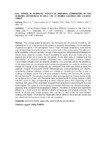Please use this identifier to cite or link to this item:
http://www.alice.cnptia.embrapa.br/alice/handle/doc/1037853Full metadata record
| DC Field | Value | Language |
|---|---|---|
| dc.contributor.author | BONONI, L. | pt_BR |
| dc.contributor.author | VASCONCELLOS, R. L. F. | pt_BR |
| dc.contributor.author | TAKETANI, R. G. | pt_BR |
| dc.contributor.author | VILELA, E. S. D. | pt_BR |
| dc.contributor.author | MOITINHO, M. A. | pt_BR |
| dc.contributor.author | MELO, I. S. de | pt_BR |
| dc.date.accessioned | 2016-02-19T11:11:11Z | pt_BR |
| dc.date.available | 2016-02-19T11:11:11Z | pt_BR |
| dc.date.created | 2016-02-19 | pt_BR |
| dc.date.issued | 2015 | pt_BR |
| dc.identifier.citation | In: CONGRESSO BRASILEIRO DE MICROBIOLOGIA, 28., Florianópolis. Anais... Florianópolis: Sociedade Brasileira de Microbiologia, 2015. Ref. 0973-1. | pt_BR |
| dc.identifier.uri | http://www.alice.cnptia.embrapa.br/alice/handle/doc/1037853 | pt_BR |
| dc.description | Abstract: The average global temperature has increased and will continue increasing, with forecast of up to 5.8° C by the end of this century as a result of the increase in the concentration of greenhouse gases in the atmosphere. Due to these increased temperature, some biomes may introduce features of arid and semi-arid environments in the coming years. The patterns of water availability in the soil can select groups of microorganisms with physiological strategies to tolerate these seasonal changes. Nutrient availability for plants becomes limited when the aqueous part of the soil is low in the dry period. On the other hand, in irrigated soils the concentration of nutrients available associated with mineralization increases rapidly. Environmental indicators such as seasonal variations in the enzymatic activity, the abundance of microorganisms and soil physical and chemical characteristics, are useful to measure and analyze the change of the functionality soil microbiota. This work was aimed to study the seasonal changes of enzymatic activity (dehydrogenase, acid phosphatase and alkaline, arylsulfatase, phytase, cellulase, amylase and urease) of microbial communities in soils of Caatinga and Atlantic Forest. The soils were collected in Bertioga-SP, Cananéia-SP, Juazeiro-BA and Petrolina-PE. The samples of soil were sifted and separated into 18 glass bottles of 200 mL containing 50 g of each soil. The bottles were incubated at 28° C varying moisture in 60% and 30% every 14 days corresponding to three seasonal cycles. The sequencing of 16S ribosomal RNA gene (rRNA) of samples was performed using the Ion Sequencing Kit 400 (Life Technologies). The dynamics of the bacterial communities had influences of seasonal changes, especially when compared the biogeographic patterns. The effect of moisture was significantly different (p < 0.05) only to the activity of alkaline phosphatase and phytase enzymes. The activity of all enzymes, except phytase, was important to discriminate the soils between Caatinga and Atlantic Forest biomes. Seasonality had an effect on the enzymatic activity that was related with the functional change in the soil microbiota. | pt_BR |
| dc.language.iso | eng | eng |
| dc.rights | openAccess | eng |
| dc.subject | Arid environments | pt_BR |
| dc.subject | Seasonality | pt_BR |
| dc.subject | Soil microbiota | pt_BR |
| dc.title | Change in enzymatic activity of microbial communities on the seasonal differences in soils the of biomes caatinga and atlantic forest. | pt_BR |
| dc.type | Resumo em anais e proceedings | pt_BR |
| dc.date.updated | 2016-04-15T11:11:11Z | pt_BR |
| dc.subject.thesagro | Caatinga | pt_BR |
| dc.subject.nalthesaurus | Dry environmental conditions | pt_BR |
| dc.subject.nalthesaurus | Enzyme activity | pt_BR |
| dc.subject.nalthesaurus | Soil microorganisms | pt_BR |
| riaa.ainfo.id | 1037853 | pt_BR |
| riaa.ainfo.lastupdate | 2016-04-15 | pt_BR |
| dc.contributor.institution | L. BONONI, ESALQ/USP; R. L. F. VASCONCELLOS; R. G. TAKETANI, Bolsista FAPESP; E. S. D. VILELA; M. A. MOITINHO, ESALQ/USP; ITAMAR SOARES DE MELO, CNPMA. | pt_BR |
| Appears in Collections: | Resumo em anais de congresso (CNPMA)  | |
Files in This Item:
| File | Description | Size | Format | |
|---|---|---|---|---|
| 2015RA018.pdf | 154,86 kB | Adobe PDF |  View/Open |









